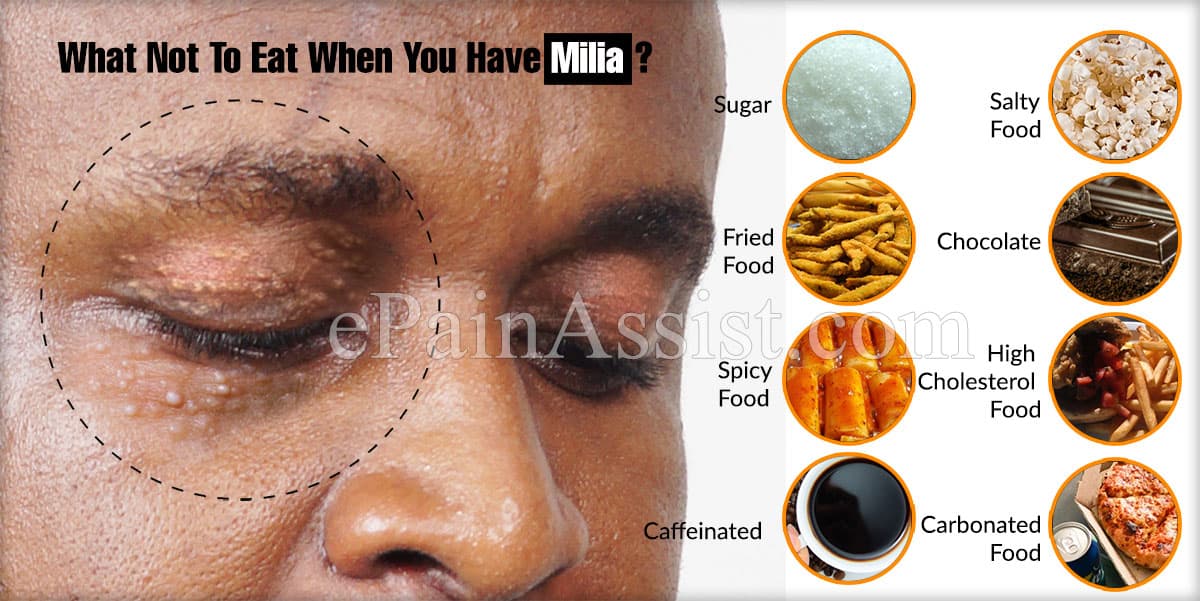Milia are small bumps of keratinized dead cells plugged beneath the surface of the skin. They are non-inflammatory growths with almost no symptoms. They develop in face, cheeks, and nose and around the lips. Milia are commonly seen in newborn babies that develop since birth. However, they disappear on their own in a few weeks. High Cholesterol and vitamin A deficiency are related to the formation of these bumps. So, diet modification may help in the control of these bumps.

What Not To Eat When You Have Milia?
The foods that you should not eat when you have milia are-
Sugar And Sugary Food. Food that is high in sugar directly increase the levels of cholesterol in the body. High cholesterol is linked with the formation of Milia.
Fried Food. Fried food like chips; french fries contribute to the elevation of cholesterol in the body. They should be avoided completely.
Spicy Food. Spicy food promotes the formation of cholesterol in the body and must be limited when you have milia.
Caffeinated And Carbonated Food. They can also elevate the levels of bad cholesterol by suppressing the levels of good cholesterol.
Salty Food. Salty food increase blood pressure that may increase the levels of cholesterol in the blood. They should be avoided to have healthy skin and body.
Chocolate. it directly raises the levels of cholesterol.
High Cholesterol Food. The food which high in saturated and trans fat others like red meat, yellow portion of eggs as they are rich in bad cholesterol.
Milia are tiny white bumps that appear in the face, nose, and cheeks. These cysts comprise of keratin, a protein found in the skin, nails, and hair. These bumps are formed due to trapping of keratin under the surface of the skin. They can appear as a single cyst or in groups. They can develop at any age but they are more commonly seen in newborns.
The food items that must be included if you have milia are-
- Fresh fruits and vegetables
- Whole grain food
- Food rich in vitamin A and D.
Milia Symptoms
Milia are small dome shaped cysts that have white or yellow heads. They do not cause itching or pain in most of the cases. In some cases, discomfort is experienced. They don’t cause any swelling or redness. On rubbing with rough sheets or clothes on Milia can render irritation or redness.
They develop typically on the face, eyelids, nose, cheeks, and lips. However, they can appear in other parts of the body as well even on genital parts. Milia are harmless growth that may disappear in a few weeks or months without treatment.
Milia Causes
The real cause is not clear. The causes of Milia can be-
- Hormones of the mother can trigger development of milia cyst in the newborn babies.
Other reasons can be-
- Injuries leading to the formation of blisters such as poison ivy
- Blistering due to ailments of skin such as porphyria, epidermolysis bullosa, etc.
- Overuse of steroid creams
- Laser resurfacing or dermabrasion
- Burns
- Longstanding Sun exposure
Lifestyle Modifications For Milia
High cholesterol and vitamin A deficiency is associated with the formation of Milia. Lifestyle should be modified in such a manner to manage cholesterol levels. This can be done by following ways:
- Regular exercises
- Avoid fatty food high in cholesterol
- Avoid smoking and alcohol consumption
- Avoid exposure to sun, use sunscreen of SPF 30 or more
- Avoid too much application of oily creams and cosmetics
- Avoid creams rich in steroids
Conclusion
Milia are small bumps found in the skin. They are formed of keratin and dead cells plugged under the skin. If you have milia, then diet can affect the formation of these plugs. It is better to avoid food high in sugar, fried and spicy food discussed above to have better results in milia.
Also Read:
